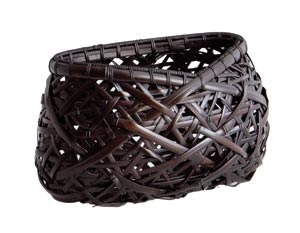
As indicated in the opening of this poem by a contemporary basket maker, bamboo – rapidly growing and quickly spreading – occupies an important position in Japanese artistic tradition. On the one hand, the delicate fronds of the natural plant appear as a recurring motif on scrolls, ceramics, and metalware. On the other, mature bamboo stalks can be used in various forms to make furniture, carts, and baskets.
A 1999 exhibition catalog quoted basket artist Minoura Chikuho (b. 1934) on the subject of the material: “Bamboo has a certain tenderness, a breathing quality. When you weave it and pattern it, light passes through it; it is transparent and solid at the same time.’
“It also retains the qualities it has in nature, flexibility and strength, with the ability to spring back into shape whenever you bend it. In winter the bamboo bends right down under the snow. When spring comes again and the snow melts, the bamboo leaps back up as if nothing has happened.”

